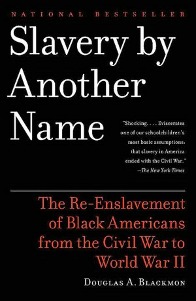Slavery by Another Name facts for kids
 |
|
| Author | Douglas A. Blackmon |
|---|---|
| Subject | African-American history, disfranchisement after Reconstruction era |
| Genre | Non-fiction |
| Publisher | Anchor Books |
|
Publication date
|
2008 |
| Pages | 468 pp. |
| ISBN | 978-0-385-50625-0 |
Slavery by Another Name is an important book by American writer Douglas A. Blackmon. It was published in 2008. The book talks about how many African American men were forced to work. This happened after the American Civil War and continued until World War II.
This forced labor was part of a system called "convict leasing." States, local governments, and companies used this system. Blackmon argues that slavery did not truly end after the Civil War. Instead, it changed forms and continued for many years. The book shows how systems like convict leasing and sharecropping kept Black Americans from being truly free.
Slavery by Another Name started as an article Blackmon wrote for The Wall Street Journal. People really responded to his article. This led him to research the topic even more deeply. The book was praised by critics and became a New York Times Best Seller. In 2009, it won the Pulitzer Prize for General Non-Fiction. Later, in 2012, it was made into a documentary film for PBS.
Contents
About the Author and His Research
Douglas Blackmon is a reporter for The Wall Street Journal. He grew up in Washington County, Mississippi. As a young student, his teacher and mother encouraged him to research a local event involving racism. This experience made him interested in the history of race relations in America.
How the Book Idea Started
In 2003, Blackmon wrote a story about Black people being forced to work. This happened in the coal mines of U.S. Steel. The story got a lot of attention. It was even included in a collection called Best Business Stories.
Blackmon then decided to research this topic more widely. He visited many courthouses in the Southern states. He looked at old records about arrests, convictions, and sentences.
What Blackmon Discovered
Blackmon was surprised by what he found. He realized there were no records of huge crime waves by Black people. Instead, the records showed something different. He found that new, harsh laws were put in place. These laws were used to unfairly arrest and force Black people to work.
He explained that real crime waves often involved white people after the Civil War. But Black people were often blamed. This blame was used as an excuse to create unfair legal rules. The book Slavery by Another Name was published in 2008.
What the Book Is About
In Slavery by Another Name, Blackmon explains his goal. He wanted to look at American companies. He asked if they used forced labor, just like German companies used Jewish slave labor during World War II. His story about forced labor in the post-Civil War South got a huge response. This inspired him to write the book.
The Story of Green Cottenham
Blackmon tells part of the story through the life of a young African American man named Green Cottenham. Green was born in the 1880s to parents who had been enslaved. In 1908, he was arrested for vagrancy. This was a common excuse to arrest Black people who didn't have a white employer or protector.
The state of Alabama then rented Green Cottenham out as a worker. He was sent to a coal mine owned by U.S. Steel Corporation. Green Cottenham later died there.
The Rise of Industrial Slavery
The book describes the start of "industrial slavery." This is when forced laborers worked in factories or mines. This was different from the old system where enslaved people worked on cotton fields. Even though the Thirteenth Amendment to the United States Constitution ended slavery, new problems arose.
After the Civil War, Southern states passed "Black Codes." These were laws designed to control Black people's lives. They made it easy to arrest Black people for small things. Often, Black people couldn't pay small fines. So, they were sentenced to forced labor.
These forced workers were then leased to plantations, lumber camps, and mines. For example, Joseph E. Brown, a former governor of Georgia, became very rich. He used forced convict labor in his coal mines from 1874 to 1894.
The End of Convict Leasing
In the early 1900s, some federal lawyers tried to stop this system. But they didn't get much support. People in the North were focused on other issues like immigration and World War I. The convict lease system finally ended around World War II. At that time, the country needed unity. The government also needed to mobilize the military. This brought more attention to racial issues.
In the end of the book, Blackmon says it's important to know this history. He believes we must understand this difficult past. He wants us to teach our children the truth about this time. He hopes the book helps us understand a painful part of American history.
The Film Adaptation
Slavery by Another Name was made into a 90-minute documentary film. It first showed on PBS in February 2012. The film was produced by Catherine Allan and Douglas Blackmon. Sam Pollard directed it, and Laurence Fishburne narrated it.
Film Reception
Neil Genzliger from The New York Times said the film helps us understand why race issues have been so hard to solve. He felt it filled in a missing part of Black history. Kunbi Tinuoye of the Griot called it a "powerful documentary." She noted it challenges the idea that slavery ended completely with the Emancipation Proclamation.
The film was part of a project called "Created Equal: America's Civil Rights Struggle." This project aimed to share civil rights history across the country.
Images for kids


